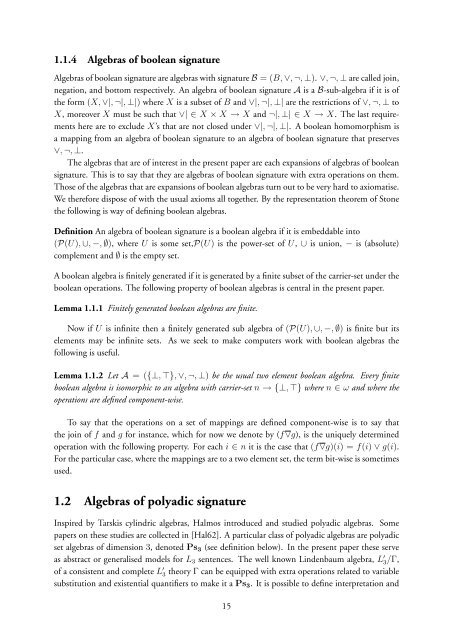On the methods of mechanical non-theorems (latest version)
On the methods of mechanical non-theorems (latest version)
On the methods of mechanical non-theorems (latest version)
You also want an ePaper? Increase the reach of your titles
YUMPU automatically turns print PDFs into web optimized ePapers that Google loves.
1.1.4 Algebras <strong>of</strong> boolean signature<br />
Algebras <strong>of</strong> boolean signature are algebras with signature B = (B, ∨, ¬, ⊥). ∨, ¬, ⊥ are called join,<br />
negation, and bottom respectively. An algebra <strong>of</strong> boolean signature A is a B-sub-algebra if it is <strong>of</strong><br />
<strong>the</strong> form (X, ∨|, ¬|, ⊥|) where X is a subset <strong>of</strong> B and ∨|, ¬|, ⊥| are <strong>the</strong> restrictions <strong>of</strong> ∨, ¬, ⊥ to<br />
X, moreover X must be such that ∨| ∈ X × X → X and ¬|, ⊥| ∈ X → X. The last requirements<br />
here are to exclude X’s that are not closed under ∨|, ¬|, ⊥|. A boolean homomorphism is<br />
a mapping from an algebra <strong>of</strong> boolean signature to an algebra <strong>of</strong> boolean signature that preserves<br />
∨, ¬, ⊥.<br />
The algebras that are <strong>of</strong> interest in <strong>the</strong> present paper are each expansions <strong>of</strong> algebras <strong>of</strong> boolean<br />
signature. This is to say that <strong>the</strong>y are algebras <strong>of</strong> boolean signature with extra operations on <strong>the</strong>m.<br />
Those <strong>of</strong> <strong>the</strong> algebras that are expansions <strong>of</strong> boolean algebras turn out to be very hard to axiomatise.<br />
We <strong>the</strong>refore dispose <strong>of</strong> with <strong>the</strong> usual axioms all toge<strong>the</strong>r. By <strong>the</strong> representation <strong>the</strong>orem <strong>of</strong> Stone<br />
<strong>the</strong> following is way <strong>of</strong> defining boolean algebras.<br />
Definition An algebra <strong>of</strong> boolean signature is a boolean algebra if it is embeddable into<br />
(P(U), ∪, −, ∅), where U is some set,P(U) is <strong>the</strong> power-set <strong>of</strong> U, ∪ is union, − is (absolute)<br />
complement and ∅ is <strong>the</strong> empty set.<br />
A boolean algebra is finitely generated if it is generated by a finite subset <strong>of</strong> <strong>the</strong> carrier-set under <strong>the</strong><br />
boolean operations. The following property <strong>of</strong> boolean algebras is central in <strong>the</strong> present paper.<br />
Lemma 1.1.1 Finitely generated boolean algebras are finite.<br />
Now if U is infinite <strong>the</strong>n a finitely generated sub algebra <strong>of</strong> (P(U), ∪, −, ∅) is finite but its<br />
elements may be infinite sets. As we seek to make computers work with boolean algebras <strong>the</strong><br />
following is useful.<br />
Lemma 1.1.2 Let A = ({⊥, ⊤}, ∨, ¬, ⊥) be <strong>the</strong> usual two element boolean algebra. Every finite<br />
boolean algebra is isomorphic to an algebra with carrier-set n → {⊥, ⊤} where n ∈ ω and where <strong>the</strong><br />
operations are defined component-wise.<br />
To say that <strong>the</strong> operations on a set <strong>of</strong> mappings are defined component-wise is to say that<br />
<strong>the</strong> join <strong>of</strong> f and g for instance, which for now we denote by (f∨g), is <strong>the</strong> uniquely determined<br />
operation with <strong>the</strong> following property. For each i ∈ n it is <strong>the</strong> case that (f∨g)(i) = f(i) ∨ g(i).<br />
For <strong>the</strong> particular case, where <strong>the</strong> mappings are to a two element set, <strong>the</strong> term bit-wise is sometimes<br />
used.<br />
1.2 Algebras <strong>of</strong> polyadic signature<br />
Inspired by Tarskis cylindric algebras, Halmos introduced and studied polyadic algebras. Some<br />
papers on <strong>the</strong>se studies are collected in [Hal62]. A particular class <strong>of</strong> polyadic algebras are polyadic<br />
set algebras <strong>of</strong> dimension 3, denoted Ps 3 (see definition below). In <strong>the</strong> present paper <strong>the</strong>se serve<br />
as abstract or generalised models for L 3 sentences. The well known Lindenbaum algebra, L ′ 3/Γ,<br />
<strong>of</strong> a consistent and complete L ′ 3 <strong>the</strong>ory Γ can be equipped with extra operations related to variable<br />
substitution and existential quantifiers to make it a Ps 3 . It is possible to define interpretation and<br />
15
















